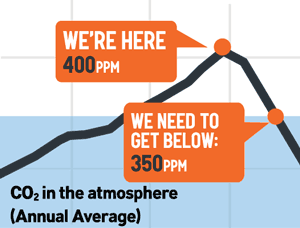“If humanity wishes to preserve a planet similar to that on which civilization developed and to which life on Earth is adapted, paleoclimate evidence and ongoing climate change suggest that CO2 will need to be reduced from [current levels] to at most 350 ppm.”
Dr. James Hansen
That’s Dr. James Hansen talking, former head of the Goddard Institute for Space Studies. Dr. Hansen is one of the most respected climatologists in the world, and when he says that climate change is incompatible with human civilization, we think human civilization ought to sit up and take notice.
That “350 ppm” is where 350.org gets its name. “PPM” stands for “parts per million,” which is simply a way of measuring the ratio of carbon dioxide molecules to all of the other molecules in the atmosphere. Many scientists, climate experts, and progressive national governments agree with Dr. Hansen that 350 ppm is the “safe” level of carbon dioxide.
Since the beginning of human civilization, our atmosphere contained about 275 ppm of carbon dioxide. That is the planet “on which civilization developed and to which life on earth is adapted.” Beginning in the 18th century, humans began to burn coal, gas, and oil to produce energy and goods. The amount of carbon in the atmosphere began to rise, at first slowly and now more quickly. Many of the activities we do every day like turning the lights on, cooking food, or heating our homes rely on energy sources that emit carbon dioxide and other heat-trapping gases. We’re taking millions of years worth of carbon, once stored beneath the earth as fossil fuels, and releasing it into the atmosphere.
Right now we’re at 400 ppm, and we’re adding 2 ppm of carbon dioxide to the atmosphere every year. Unless we are able to rapidly turn that around and return to below 350 ppm this century, we risk triggering tipping points and irreversible impacts that could send climate change spinning truly beyond our control.
So far, we’ve experienced about 1 degree (Celsius) of warming, and the impacts are frightening. Glaciers everywhere are melting and disappearing fast, threatening the primary source of clean water for millions of people. Mosquitoes, who like a warmer world, are spreading into lots of new places, and bringing malaria and dengue fever with them. Drought is becoming much more common, making food harder to grow in many places. Sea levels have begun to rise, and scientists warn that they could go up as much as several meters this century. If that happens, many of the world’s cities, island nations, and farmland will be underwater. Meanwhile, the oceans are growing more acidic because of the CO2 they are absorbing, which makes it harder for animals like corals and clams to build their shells and exoskeletons. All around the globe, we’re stacking the deck for extreme weather — like hurricanes, typhoons, blizzards, and droughts — which exacerbates conflicts and security issues in regions that are already strapped for resources.
The Arctic is sending us perhaps the clearest message that climate change is occurring much more rapidly than scientists had previously thought. In the summer of 2012, roughly half of the Arctic’s sea ice went missing (some scientists estimate that the total volume of summer sea ice loss may be as high as 80%). The entire Arctic region is undergoing drastic changes, threatening vital habitat for countless species (yes, including polar bears) and the livelihoods of many indigenous communities. This is also bringing us closer to dangerous tipping points, like the breakdown of the Greenland ice sheet and major methane releases from quickening permafrost melt.
This is the science of climate change. While much of the details are still being studied, one thing is no longer up for debate: our climate is changing profoundly and rapidly, and human activity is the cause.
Sources & Resources:
A Safe Operating Space for Humanity. Nature 461, 472-475 (24 September 2009); doi:10.1038/461472a; Published online 23 September 2009.
Hansen, James, et al. Target Atmospheric CO2: Where Should Humanity Aim? Submitted April 7, 2008. NASA climate scientist James Hansen’s paper about the 350ppm target. Be sure to also explore Dr. Hansen’s “Climate Science, Awareness, and Solutions” program at Columbia University’s Earth Institute.
The IPCC 5th Assessment Report. The latest report by the Nobel-prize winning United Nations Intergovernmental Panel on Climate Change, supported by the world’s leading climatologists.
The United Nations Framework Convention on Climate Change. Link to the official UNFCCC website with information about the UN climate policy process.
Baer, Paul, Tom Athanasiou and Sivan Kartha. “The Right to Develop in a Climate Constrained World: The Greenhouse Development Rights Framework.” An important policy framework for how to mitigate climate change while ensuring an equitable path to development for the Global South.





